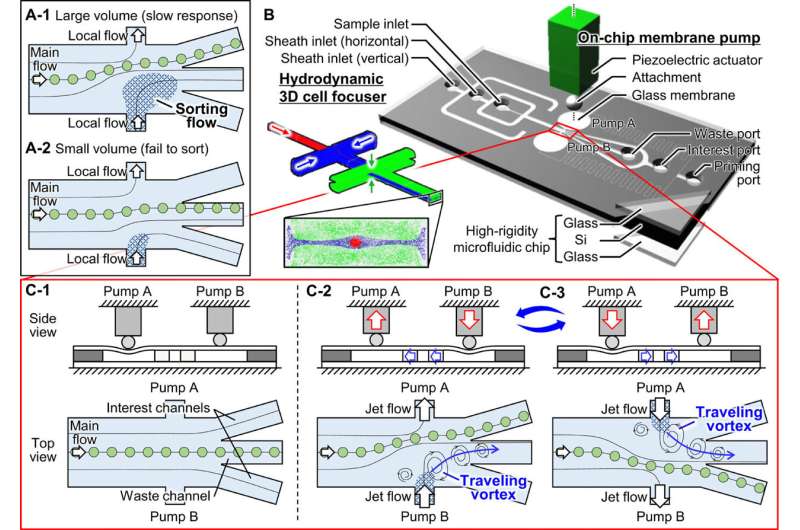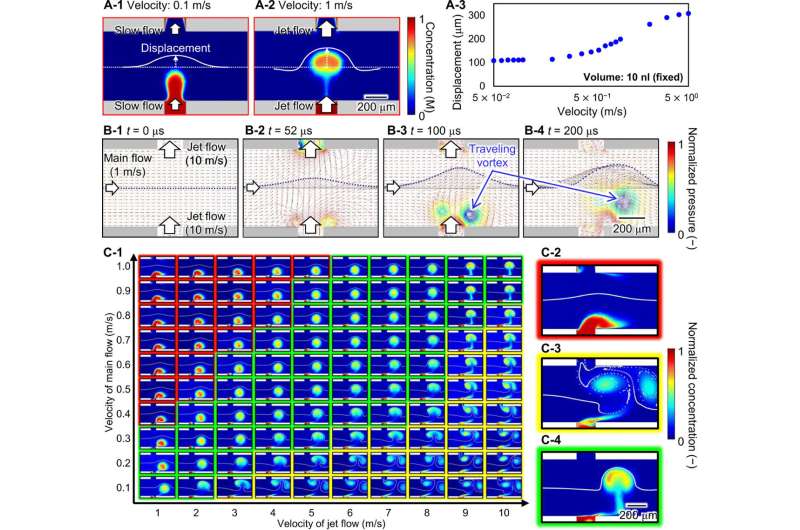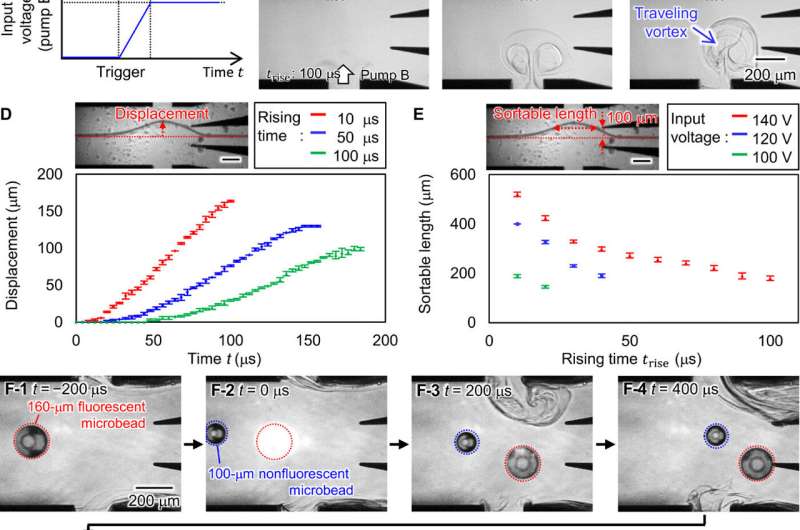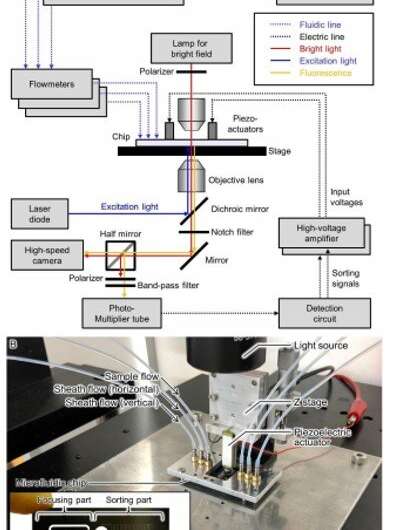Conceptual images of the proposed on-chip sorting system for large particles based on spatiotemporally generated traveling vortices. (A) Conceptual images of conventional on-chip particle sorting using laminar flow conditions for the cases of (A-1) large sorting volume, which causes slow flow control response, and (A-2) small sorting volume, which fails to sort large particles. (B) Configuration of the on-chip sorting system using on-chip membrane pumps. For clarity, only one of the two piezoelectric actuators is shown. (C) Sequence of the proposed on-chip sorting of large particles using the traveling vortex: (C-1) nonsorting state, (C-2) upward-sorting state, and (C-3) downward-sorting state. Credit: Science Advances, doi: 10.1126/sciadv.abe7327
Particle sorting is fundamental to biological and medical research, although existing methods are unable to sort large-sized particles via high-throughput sorting. In a new report, Y. Kasai and a research team in Japan, Germany and Poland presented a new on-chip sorting method based on traveling vortices generated by on-demand microjet flows. The method allowed high-throughput sorting using an activation system for fluorescent detection to sort 160 micrometer beads and purified fossil pollen from lake sediments. The method enhanced the achievement of chronologies of fossil pollen for paleoenvironmental records of sedimentary archives. The method has cross-disciplinary applications in genomics, metabolomics and regenerative medicine. It will open up new opportunities for pollen use in geochronology, paleoecology and paleoclimatology. The work is now published on Science Advances.
Cell sorting in the lab
Fluorescence-activated cell sorting (FACS) is a fundamental method in biology, medicine, plant science and agriculture. The method can allow researchers to detect and sort diverse biogenic fluorescent particles, including cells at high throughput, based on multiple physical and chemical properties including size, morphology and fluorescence. There are two basic types of FACS devices that use different sorting methods; a conventional particle sorter that relies on aerosol generation and an on-chip particle sorter that does not rely on aerosol generation to sort particles in a microfluidic chip. FACS is a groundbreaking method in paleoecology and paleoclimatology to concentrate and purify microfossils to reconstruct past environmental and climate changes for human-environment interactions.
In this work, Kasu et al. presented an on-chip particle sorting method capable of processing large particles via spatiotemporal traveling vortices generated by an on-demand, small-volume microjet flow to locally exceed laminar conditions. First, the researchers analyzed and experimentally determined the performance of traveling vortex generation. Next, they tested the response time and sortable length of vortex-based flow control for high-throughput, large-particle sorting. Thereafter, they verified the high-throughput large particle sorting method using fluorescent microbeads and then ran tests on pre-treated ancient lake deposits to understand the ability of the method to sort fossil pollen. In the final experimental step, they also used accelerator mass spectrometry (AMS) carbon dating techniques.
Flow simulation of a spatiotemporally generated traveling vortex. (A) Computational fluid dynamics (CFD) analyses of displacement at sorting velocity of (A-1) 0.1 m/s and (A-2) 1 m/s and (A-3) relationship between displacement and sorting velocity with fixed sorting volume of 10 nl. (B) Simulation of on-chip sorting using a spatiotemporally generated traveling vortex. Line of blue dots and black lines indicate 10-μm particles and their flow path, respectively. Red arrows indicate streamline of the flow. Color isodose chart indicates the normalized pressure of the flow (see movie S1 for details). (C) Effect of the main velocity on the vortex generation with red, yellow, and green frames of each image, indicating conditions with small displacement (<100 μm), too large displacement where the vortex reaches the channel wall, and proper displacement (>100 μm), respectively. (C-1) Parametric analysis of the velocity-vortex generation relationship with various velocities of the main flow and jet flow. Images of typical vortex generation at (C-2) 1.0 m/s of main flow and 1 m/s of local flow, (C-3) 0.1 m/s of main flow and 10 m/s of jet flow, and (C-4) 1.0 m/s of main flow and 10 m/s of jet flow. Credit: Science Advances, doi: 10.1126/sciadv.abe7327
Working principles of the on-chip sorting system.
The team next described the working principles of the on-chip sorting system. Before sorting, they introduced the particle suspension through the sample inlet using a pressure pump. Next, they focused the particles into the center of the main microchannel using horizontal and vertical sheath flows from a hydrodynamic 3D cell focuser. The focused particles flowed to the sorting area while non-target particles were directed into a waste channel. When the scientists detected a target particle, they sent it to the piezoelectric actuators to trigger the on-chip membrane pumps and generate a microjet flow by pushing and pulling the membrane pumps. The jet flow generated a traveling vortex immediately behind the wall of the main microchannel. The scientists continuously sorted the target particles via push/pull actuation of the on-chip membrane pumps. Kasu et al. next studied the jet-flow velocity effect for particle displacement using COMSOL Multiphysics. The researchers then experimentally verified the effect of the jet velocity on vortex generation. Higher-input voltages lead to larger displacement of the piezoelectric actuator and shorter rising times led to faster actuation. Using an experimental setup, they then showed that the fast jet flow successfully generated a vortex in the microchannel within 100 microseconds, while the slow jet flow did not.
Summarized evaluation of the vortex-based flow control and results of sorting 160-μm fluorescent microbeads. (A) Waveforms of the voltage input to the piezoelectric actuators. Sequential photographs of slow flow control with rising times of (B) 500 μs and (C) 100 μs (see movie S2 for details). (D) Response time of the displacement of the main flow path. (E) Relationship between sortable length and rising time. (F) Sequential photographs of on-chip sorting of 160-μm fluorescent microbeads (see movies S3 and S4 for details). (G) Photographs of samples (G-1) before and (G-2) after sorting. Credit: Science Advances, doi: 10.1126/sciadv.abe7327
Flow profile and sorting performance test using microbeads.
The team next analyzed the relationship between response time and sortable length of the proposed vortex-based flow control. To visualize the flow profile, Kasu et al. used 3D focused sample flow with 200 nm nonfluorescent microbeads. The proposed on-chip flow control method based on training vortices has potential to control a large sortable length of up to 520 µm with high-speed actuation of 5 kHz. The outcome represented the main technical advance of the setup compared to the previous developmental sorter designed for smaller particles. To understand the performance of the proposed sorting method, Kasu et al. conducted high-speed on-chip sorting with 160 µm fluorescent microbeads as large, standardized particles. During this experiment, they used denatured alcohol to visualize sorting flow. To observe the main flow, they introduced sorbitol solution, which also helped reduce the sedimentation velocity of the microbeads. The microbeads traveled directly towards the detection point for discovery, and a traveling vortex generated in the setup, allowed the shift and detection of microbeads in the upper or lower interest channel. In contrast, non-fluorescent microbeads traveled into the waste channel without being affected by traveling vortices. The team analyzed the performance of on-chip sorting relative to the success rate, purity and maximum throughput. They then counted the number of target particles and sorted non-target particles on the recorded video files to show the effect of high-speed on-chip sorting of large fluorescent particles.
Overview of the constructed on-chip sorting system for large particles. (A) Schematic overview of the onchip FACS system. (B) Photograph of the experimental setup. One piezoelectric actuator and the associated z-stage were removed for clarity Credit: Science Advances, doi: 10.1126/sciadv.abe7327
Proof-of-concept—sorting fossil pollen
The team tested the applicability of the newly developed large particle on-chip sorting method to concentrate and purify the fossil pollen. To accomplish this, they used two samples of glacial lake sediments from lake Suigetsu and lake Biwa. Before sorting the sample, the scientists physically and chemically pre-treated the sample to remove as many nonpollen particles, while maintaining the work effort and expenses at a minimum. The team classified the nonpollen and spore particles in the sorted samples as unidentified organic debris, including the remnants of plant fibers and microorganisms, due to their different fluorescence properties to pollen. To assess the accuracy of the pollen concentrate purified by the on-chip sorting method, Kasu et al. conducted 14C dating on the extracts. The outcomes revealed the age of three of them to be statistically in agreement with the existing chronologies in reference ages.
Flow simulation of sorting by a traveling vortex. Credit: Science Advances, doi: 10.1126/sciadv.abe7327
Outlook
In this way, Y. Kasai and colleagues presented a sorting method capable of sorting most pollen taxa from the smallest types to the large types of up to 170 µm at high throughput. The work allows efficient concentration of fossil pollen from any sedimentary deposit for 14C dating or other analytical applications. This is a breakthrough achievement, when compared to a conventional particle sorter. The method is however limited by its inability to distinguish reworked pollen from non-reworked pollen during 14C dating. Using highly pure pollen concentrates sorted by the new on-chip sorter, Kasu et al. presented a valuable approach to overcome the problem. The sorter is compatible with varied methods in biomedicine with potential applications to obtain highly pure concentrates for stable isotope and ancient DNA analyses to explore new avenues in diverse research fields.
More information: Yasai K. et al. Breakthrough in purification of fossil pollen for dating of sediments by a new large-particle on-chip sorter, Science Advances, DOI: 10.1126/sciadv.abe7327
Pechhold S. et al. Transcriptional analysis of intracytoplasmically stained, FACS-purified cells by high-throughput, quantitative nuclease protection. Nature Biotechnology, doi.org/10.1038/nbt.1579
Kawakatsu T. et al. Unique cell-type-specific patterns of DNA methylation in the root meristem. Nature Plants doi.org/10.1038/nplants.2016.58
Journal information: Science Advances , Nature Plants , Nature Biotechnology
© 2021 Science X Network



























